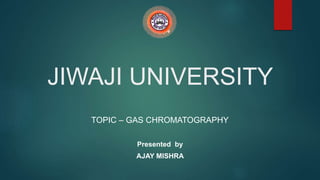
Gas Chromatography: A Concise Guide to GC Separation and Analysis
- 1. JIWAJI UNIVERSITY TOPIC – GAS CHROMATOGRAPHY Presented by AJAY MISHRA
- 2. CHROMATOGRAPHY Mikhail Tswet invented chromatography in 1901 during his research on plant pigments. Paper chromatography was introduced by Martin and Syngle in 1943 for the first time , the means of surveying constituents of plant and for their separation and identification. It is a method of separating components of a mixture by differential movement through a two phase system one is mobile phase and another is stationary phase. This movement is effected by the flow of a liquid or a gas is ( mobile phase ). and which percolates through an adsorbent is ( stationary phase ).
- 3. METHODS OF SEPARATION Adsorption of a substance on the stationary phase. Separation of the adsorbed substance by the mobile phase. Recovery of the separated substance by a continuous flow of the mobile phase, this method being called elution. Qualitative and quantitative analysis of the eluted substance.
- 5. Gas chromatography is a technique used for separation of volatile substance or substance that can be made volatile, from on another in a gaseous mixture at high temperature. A sample containing the materials to separated is injected into the gas chromatograph. A mobile phase (carrier gas) moves through a column that contain a wall coated stationary phase. As the carrier gas flows through the column. The sample come in contact with the stationary phase.
- 6. Types of gas chromatography
- 7. Gas solid chromatography ( GSC) In this case the stationary phase is a solid like silica and alumina. The mobile phase is a carrier gas. It is based upon a solid stationary phase in which retention of analytes is the consequence of physical adsorption. This gas chromatographic technique is most useful for the separation and analysis of low molecular weight gases like methane (CH4) ,carbon dioxide(CO2 ), carbon monoxide (CO).
- 8. Gas liquid chromatography The stationary phase is a thin layer of a non-volatile liquid bound to a solid support. The mobile phase is a suitable carrier gas. It is based upon the partition of the analyte between a gaseous mobile phase and a liquid phase immobilized on the surface of on inert solid. GLC is the most widely used technique for separation of volatile species.
- 11. A carrier gas. A sample injection system. The separation column. Detectors. Thermo stated chamber for the temperature regulation of the column and detectors. An amplification and recorder system.
- 12. Carrier gas : I. Highly pure (>99.9%) II. Inert so that no reaction with stationary phase. III. Compatible with the detector since some detector require the use of a specific carrier gas.
- 13. A sample injection system. I. These are composed of a glass tube where vaporization of the sample takes place. II. The sample is introduced into the injector through a self-sealing silicone rubber septum. III. The temperature of the injector is not enough ( at least 50 degree above highest boiling component ) , band broadening will take place.
- 14. Column configuration or column ovens : I. A column can either be a packed or a open tubular/capillary columns. II. Packed columns are relatively short (~2meters) while open tubular columns may be as long as 30-100meters. III. Packed columns are made for stainless steel or glass while open tubular columns are usually made of a fused silica.
- 15. Detectors: 1. Flame ionization detector (FID) • Mass sensitive • Weakly sensitive to carbonyl, amine, alcohol, amine group • not sensitive to non-combustibles H2O , CO2 ,SO2 • Only detect for carbon containing compounds.
- 16. 2. Thermal conductivity detector ( TCD ) • Less sensitivity • Decrease in temperature increases in signals. • The TCD is also used in analysis of permanent gases (argon,oxygen, nitrogen, carbon dioxide) because it responds to all These pure substance unlike the FID which can’t detect compound which do not contain carbon- hydrogen bonds.
- 17. 3. Electron capture detector (ECD): • This detector exhibits high intensity for halogen containing compound. • Such as pesticides and polychlorinated biphenyls. • Mass sensitive detector. • It is widely used detector for environment detector halogen containing compound. • Compared with the FID, The ECD is more specialized.
- 18. 4. Thermionic ionization detectors (TID): • It is similar in design to the FID. • Selective to nitro functional groups. • The TID is extremely selective, having little or no response to most aromatic and aliphatic hydrocarbons. • This detector also responds to chlorinated phenols, such as pentachlorophenol , at slightly less sensitivity. • Mostly use for fertilizer.
- 19. Applications
- 20. The principle application of GC are qualitative and quantitative analysis of liquids, gaseous and vapors particularly of organic compounds. Qualitative analysis : I. By comparing the retention time or volumes of the unknown to the retention times. II. By collecting the individual components as they emerge from the chromatograph and subsequently identifying these components by other methods. Quantitative analysis : I. Quantitative analysis of chromatogram depends upon the fact that the area under a single component elution peak is proportional to the quantity of the detected component.
- 21. Merits and demerits of GC
- 22. Merits of GC : • This method has a high resolution power compared to other methods. • This method has high sensitivity when used with thermal detectors. • This technique gives relatively good accuracy and precision. • Separation and analysis of sample very quickly. • Sample with less quantity is also separated.
- 23. Demerits of GC : • Only volatile sample or the sample which can be made volatile are separated by this method. • During injection of the gaseous sample proper attention is required. • The sample of gas which is about to inject must be thermally stable so that it does not get degraded when heated.
- 24. REFERENCES S.M.Khopkar. Internet https://en.wikipedia.org/wiki/Decomposition_potential http://jes.ecsdl.org/content/66/1/359
